Defence Minister honours top mathematician
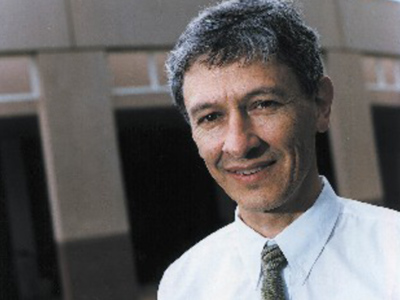
A scientist with a distinguished career in crypto-mathematics is the winner of the 1999 Minister's Award for Achievement in the Defence Science and Technology Organisation (DSTO).
Dr Ian Doherty, a senior principal research scientist with DSTO's Communications Division, has been recognised for his sustained and high quality research, leadership and personal contributions to the science of secure communications.
Dr Doherty's research has addressed many key Defence priorities in the area of secure communications, in particular the establishment of a strong capability in crypto-mathematics - the mathematical theory of codes and cyphers.
One of the more widely known achievements of Dr Doherty and his research group was the development of the critical technology that made possible the SPEAKEASY secure communications system. It is now used extensively for classified Australian Government communications.
The Minister for Defence, Mr John Moore, presented Dr Doherty, 52, of Canberra, with the award and $15,000 winner's cheque at a ceremony at Parliament House today.
In making the presentation, Mr Moore said Dr Doherty was a worthy recipient of the prestigious award, which is presented annually to acknowledge outstanding and original work in enhancing Australia's defence effectiveness.
"In his career with DSTO, Dr Doherty has consistently demonstrated a high quality of leadership and innovation in crypto-mathematics research, which has won him the respect of his military and scientific peers," Mr Moore said.
"This Achievement Award acknowledges the important role of Dr Doherty and other DSTO scientists and engineers in contributing to Australia's defence capability through their significant advances in leading edge research and technology."
In 1988 Dr Doherty established, and was the inaugural head of, a mathematical research group in DSTO. He recruited a team of talented and innovative scientists, and under his leadership the group has been highly successful in solving problems critical to Defence.
Dr Doherty's personal contributions in crypto-mathematics have ranged across many aspects of the science, including the design of cryptographic algorithms, the measurement of unintended electromagnetic radiation, the reliability of communications systems, and the assessment of cryptographic systems proposed for use by the Australian Government.
The value of this important work has been recognised by Australia's allies.
Dr Doherty currently holds a research leadership position in DSTO in conjunction with a senior management position in the Defence Signals Directorate (DSD). Dr Doherty has been highly successful in this dual role, facilitating the transition of research results into operational effectiveness within Defence.
Achievement award for Defence scientist
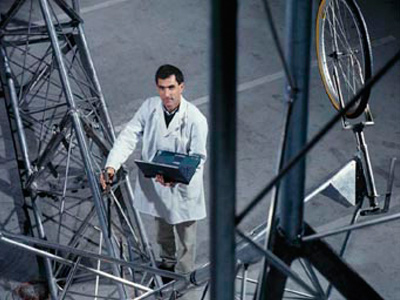
Dr Chris Norwood was today recognised for his significant contributions to the management and control of noise and vibration in maritime platforms, particularly the Collins Class submarine.
At the Defence Science and Technology Organisation (DSTO) in Melbourne today, a 2000 Minister's Award was awarded to Dr Chris Norwood.
Dr Norwood receives the award for his significant contributions to the management and control of noise and vibration in maritime platforms, particularly the Collins Class submarine.
His outstanding scientific leadership has brought himself and his team international recognition in the field of acoustics and vibration.
New Australian Submarines
The work conducted by Dr Norwood contributed significantly to fast-tracking new Australian submarines HMAS Dechaineux and HMAS Sheean to a desired level of capability by the end of 2000.
Dr Norwood and his team have developed advanced techniques for measuring and controlling the noise of the submarines, thereby reducing their "visibility".
His work is an example of the world-class research being undertaken at DSTO to enhance Australia's defence capabilities.
The Minister's award for achievement was established in 1987 to recognise and reward scientific talent in the Defence organisation.
Past winners include scientists recognised for their work in areas such as the Jindalee Over-the-Horizon Radar (JORN), crack patching technology for repairing aircraft structures, high performance steel and welding in the construction of the Collins Class submarine and electronic support measures for electronic warfare.
Combat clothing expert wins science award
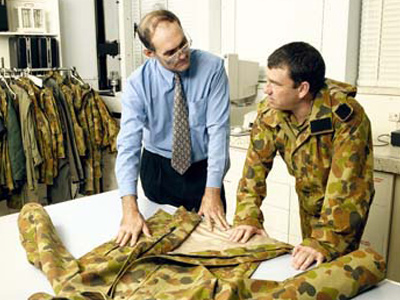
Defence Minister Robert Hill today presented the 2002 Minister's Award for Achievement in Defence Science to Graeme Egglestone from Defence Science and Technology Organisation (DSTO) for developing a range of innovative combat clothing for Australian soldiers.
The award was presented at a function at DSTO in Melbourne.
A scientist with DSTO since 1968, Mr Egglestone leads a small team developing clothing that provides protection against ballistic impact, biological and chemical agents and visual and near-infrared camouflage.
“Mr Egglestone’s contribution to Defence in conceiving, developing and bringing into service a range of combat clothing ensembles has delivered critical protection for our forces while they serve in the most demanding of environments,” Senator Hill said.
“Our forces in Iraq are supplied with the most effective camouflage desert uniform and a lightweight Chemical Biological Combat (CBC) Suit, both of which were developed by his team.”
The camouflage design was designed at short notice to suit the terrain in Afghanistan better than the standard pattern. The CBC suit is breathable, so personnel can work harder and longer in extreme conditions without risking exposure to chemicals.
The team also developed a fabric for all new combat clothing allowing our forces to be better camouflaged against night vision surveillance. Overseas laboratories have established big teams to address this problem.
The Australian CBC suit has proven to be better suited to Australian Defence operations and in some aspects has outperformed other international protective garments used for the same purpose.
Senator Hill said he was particularly pleased that the technology developed by Defence had been transferred to industry.
“Not only is the science for the military uniforms and the CBC suit developed by Australians, the clothing itself is manufactured in Australian factories by an Australian workforce,” Senator Hill said.
Senator Hill also presented international awards for excellence in defence science to a group of Australian Defence researchers. These annual awards are presented for outstanding research activities conducted under The Technical Cooperation Program (TTCP) – Australia’s most important collaborative agreement in defence science involving the United States, United Kingdom, Canada, Australia and New Zealand.
“These prestigious awards recognise work that contributes significantly to the technological edge of the Australian Defence Force (ADF),” Senator Hill said.
"They also allow our defence scientists to benchmark their work against the world’s best and gain important international recognition.”
Senator Hill congratulated all recipients and said it was significant that the valuable work of Australia’s defence scientists was being recognised as technology continued to play an increasingly important role in ADF deployments around the world.
Other Award Recipients
This year, a total of eight awards were presented for activities undertaken by Australian Defence researchers during 2002.
Awards were presented to:
Dr Ralph Gailis
For developing a hazard assessment model to predict the dispersion of airborne materials in the event of a chemical, biological and radiological attack.
Dr Alexander Krstic, Mr Edmond Almond, Brigadier Robert Atkinson, Mr Michael Footner and Dr John Wang
For a significant contribution to the understanding of lower leg injury caused by anti-personnel landmines, the research resulting in the development of a synthetic human leg to test the effects of landmine blasts.
Dr Geoff Hugo
For contributing to collaborative research on non-destructive inspection techniques for the detection and measurement of corrosion in aging aircraft.
Dr Bruce Fairlie
For an original contribution to noise suppression in open aircraft weapon bays.
National Science Award for Electronic Warfare Expert
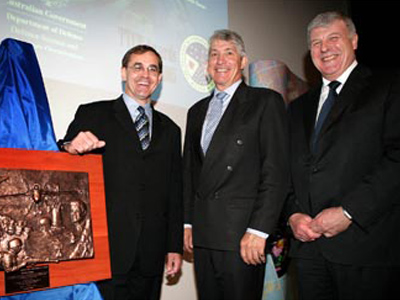
Parliamentary Secretary to the Minister for Defence Senator Sandy Macdonald today presented the 2005 Minister's Award for Achievement in Defence Science to Dr Tony Lindsay for his outstanding achievement in enhancing protection for Australian Defence Force (ADF) aircraft against electronic warfare threats.
Senator Macdonald said Dr Lindsay, a member of the Defence Science and Technology Organisation (DSTO), provided invaluable technical leadership over six years on an Australia-US project, one of the largest joint research and development (R&D) efforts between the two countries.
"Dr Lindsay's many years of dedication and scientific leadership have made a major difference to the Royal Australian Air Force's (RAAF) capability in electronic warfare, particularly its development of countermeasures," Senator Macdonald said.
Dr Lindsay's team has developed new technologies, giving the RAAF additional capabilities in analysing and testing the performance of electronic warfare systems in complex environments, protecting ADF aircraft by detecting threats such as missiles, and launching countermeasures to jam or lure the threat away from the aircraft.
National Science Award For Defence Armour Expert
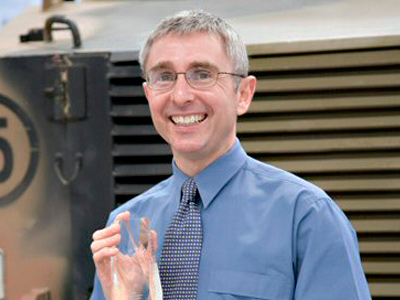
Parliamentary Secretary to the Minister for Defence, Senator Sandy Macdonald today presented a national science award to Dr Stephen Cimpoeru for his outstanding achievement in enhancing the survivability and protection of Army vehicles on operational deployments, ensuring the safety of Australian soldiers.
Dr Cimpoeru, from the Defence Science & Technology Organisation (DSTO), has been presented with the 2006 Minister’s Award for Achievement in Defence Science at a function in Melbourne. He received a trophy and a cash prize of $15,000.
Senator Macdonald said Dr Cimpoeru, widely regarded as an expert in ballistic protection and armour, has provided invaluable technical leadership in the science of armour protection for fifteen years.
“Protecting our forces on operational deployment is a high priority for the Australian Defence Force (ADF), and Dr Cimpoeru’s work has contributed directly to the ongoing safety of Australian soldiers in the field, especially in Iraq and Afghanistan,” Senator Macdonald said.
Dr Cimpoeru has been closely involved in requirements definition, technical risk assessment, procurement, testing and evaluation, analysis and enhancement of all armoured vehicle fleets within Defence.
Senator Macdonald said Dr Cimpoeru’s most significant scientific work has been in identifying the causes of failure in laminated metallic, titanium and composite based armours, and using this improved knowledge to make better analytical predictions of ballistic performance.
In 2004, when the Australian Government decided to provide survivability enhancements for light-armoured vehicles (ASLAVs) in Iraq, Dr Cimpoeru and his team urgently tested and evaluated a range of protective accessories and rapidly introduced them into service on ASLAVs and Bushmaster infantry mobility vehicles. These included external bar armours and internal spall liners which were integrated into the vehicles to protect them and the crew from rocket-propelled grenades and improvised explosive devices.
“Dr Cimpoeru coordinated a large number of complex live-fire ballistic fragmentation and blast tests at very short notice to enable this deployment to proceed with extra protection for our soldiers,” Senator Macdonald said.
“This activity made a vital contribution to enhancing operational effectiveness and protection for Australian troops.”
Dr Cimpoeru was instrumental in supporting Defence with advice and evaluation during the acquisition of the M1A1 Abrams Main Battle Tank. His pivotal role included high-level liaison with the US. His technical skill and meticulous attention to detail were critical in achieving this project.
Dr Cimpoeru has also made a significant contribution to broader national security issues. He has been advising a number of Government agencies on ballistic protection in helicopters, aircraft, ships, watercraft and VIP armoured cars.
His knowledge and efforts are helping to ensure that Australia’s VIPs, official overseas guests and ADF personnel are provided with the highest level of protection.
National Science Award for Expert in Aircraft Corrosion
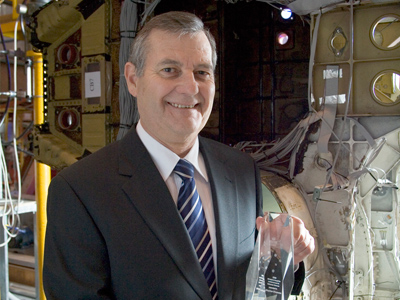
The Parliamentary Secretary to the Minister for Defence, Mr Peter Lindsay, today presented a national science award to Dr Bruce Hinton for his outstanding achievement in preventing and controlling corrosion in the Australian Defence Force (ADF) aircraft fleet.
Dr Bruce Hinton, from the Defence Science and Technology Organisation (DSTO), was presented with the 2007 Minister’s Award for Achievement in Defence Science at the Centenary of Defence Science Dinner in Melbourne.
Mr Lindsay said Dr Hinton’s innovative research had saved the Defence Force many millions of dollars over the years in maintenance and repair costs while ensuring the availability of aircraft for operational use.
"His work has contributed directly to the cost-effective maintenance, life extension and ongoing safety of Defence aircraft," Mr Lindsay said.
Aircraft Maintenance
One of the most significant contributions made by Dr Hinton and his research team has been their pioneering use of preventative compounds for treating existing corrosion, saving many maintenance hours, decreasing aircraft downtime and contributing to overall aircraft safety.
Dr Hinton has also been responsible for another cost-reducing innovation – the environmental monitoring which enables aircraft maintenance to be carried out as required depending on the actual condition of the structure rather than through spot checks at periodic intervals.
Together with the CSIRO, Dr Hinton developed a computer model that can predict the start and spread of corrosion pitting on aluminium alloy surfaces. This model is also used to manage preventative corrosion maintenance on ADF aircraft.
Mr Lindsay said Dr Hinton’s environmental and corrosion sensors and prediction models have now become the basis for programs to monitor the health of aircraft for maintenance purposes. His pioneering work will also be applied to the Joint Strike Fighter (JSF) aircraft when it comes into service with the Royal Australian Air Force (RAAF).
A recognised leader in corrosion technology around the world, Dr Hinton has co-authored 3 patents, delivered more than 70 conference papers and published 40 refereed papers, many of which have won awards for best research.
"For more than 35 years Dr Hinton has provided extremely valuable and pertinent technical advice to Defence for the acquisition of major air and maritime platforms," Mr Lindsay said.
Minister recognises scientific excellence
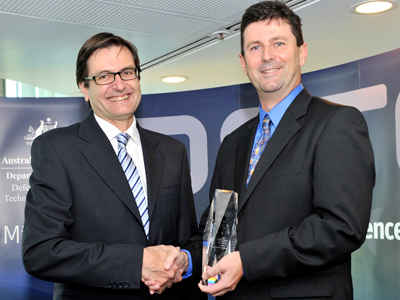
The prestigious Minister's Award for Achievement in Defence Science for 2009 has been awarded to a Defence scientist who has devoted his career to enhancing Australia's long-distance surveillance capability.
In announcing the award today, Greg Combet, Minister for Defence Personnel, Materiel and Science said, “I am pleased to present the award to Dr Gordon Frazer of the DSTO for his internationally recognised expertise and inspirational leadership in advancing both Australian and Allied capabilities in Over the Horizon Radar (OTHR).”
“Dr Frazer’s personal and sustained contribution has been instrumental in assuring that Australia remains the world leader in operational OTHR capability." said Minister Combet.
The Jindalee Operational Radar Network (JORN) was developed over many years as a result of DSTO’s research in OTHR technology beginning in the 1970s. JORN provides wide area surveillance of Australia’s strategically important northern approaches.
The JORN system has been progressively upgraded and enhanced through DSTO’s continuing research efforts and changing operational requirements.
As part of continuous improvement Dr Frazer has developed a number of major technological advances in techniques, algorithms, software and hardware that have helped to address some significant limitations on High Frequency (HF) radar performance caused by the ionosphere.
In July 2009, Dr Frazer was presented with an Award for Excellence by the National Measurement and Signature Intelligence Management Office of the US Department of Defense in recognition of his “invaluable technical expertise and leadership in support of Australia-US OTHR cooperation”.
Radar expert wins Science Achievement Award
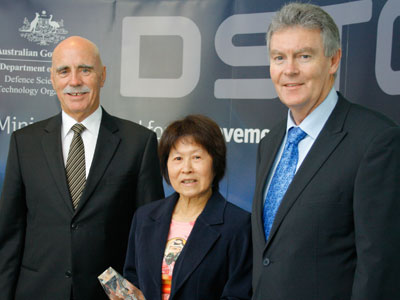
World class innovation to shield Defence ships and aircraft from radar surveillance has earned a Defence Science and Technology (DSTO) scientist a prestigious Australian award for achievement in defence science.
Minister for Defence Science and Personnel Warren Snowdon has presented the 2011 Minister's Award for Achievement in Defence Science to Cheng Anderson for her pioneering role in reducing the vulnerability of Australia’s Defence platforms over three decades.
Mr Snowdon said Dr Anderson is the principal architect of a world leading capability that allows the Australian Defence Force to predict, measure and reduce the visibility of its ships and aircraft to radar systems.
“Before Dr Anderson began her work thirty years ago Defence only had a limited capability to protect its assets adequately."
“Dr Anderson’s work has been vital in improving the stealth capabilities and ensuring the survivability of our military aircraft, ships and land vehicles,” Mr Snowdon said.
The work has involved the development of computer models to predict a platform’s visibility to radar, known as the radar cross section. The cross section can also be measured experimentally validating the computer model predictions.
The resulting information makes it possible to know where treatment should be applied to reduce a platform’s cross section.
“These are significant developments in self-protection for Defence assets and I congratulate Dr Anderson for her foresight and technical achievements,” Mr Snowdon said.
“I would also like to thank Dr Anderson on behalf of all Defence personnel for her hard work, which will save lives, while improving the capability and efficiency of our defence forces.”
“This award recognises the rare distinction of an individual scientist being solely responsible for establishing a critical defence capability,” he said.
“Dr Anderson has been extremely focussed and successful in applying this capability in the maritime, air and land environments as well as in key areas such as support to operations, through-life support of existing platforms, and acquisition projects.”
Dr Anderson is the second female scientist to have won the Minister’s Achievement Award since Dr Jackie Craig in 2001.
The Minister’s achievement award has been presented annually since 1988 to a DSTO scientist who has made an outstanding scientific contribution to enhance Defence effectiveness and efficiency. The award includes a $15,000 cash prize.
Stealth technology expert wins Minister's Science Award
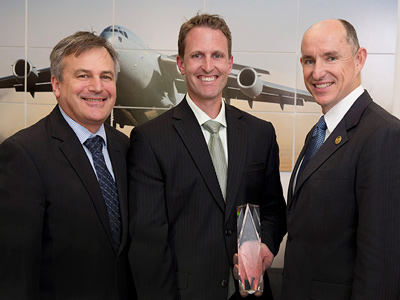
A stealth technology expert, responsible for significantly enhancing the survivability of military vehicles and vessels, has won the 2013 Minister's Award for Achievement in Defence Science.
Assistant Minister for Defence, Stuart Robert MP, congratulated Dr Andrew Amiet from the Defence Science and Technology Organisation (DSTO) for developing new solutions and techniques that have resulted in better stealth technology for Australia.
Mr Robert said Dr Amiet’s advice aided the survivability of current Australian Defence Force (ADF) vehicles and vessels and contributed to through-life cost savings and reductions in maintenance requirements.
“Dr Amiet is responsible for developing and evaluating materials with stealth capabilities for use on submarines, ANZAC ships and Army vehicles to minimise their detection by radar, sonar, infrared and other electronic systems, thus significantly improving their operational capability,” Mr Robert said.
“Dr Amiet’s achievement is a fine example of the brilliant scientific minds that make a significant contribution to Defence capability.”
Welcoming the Minister’s recognition, Dr Amiet said his aim has been to provide the ADF with a capability edge by reducing the probability of vehicles and vessels being detected and classified; thus enhancing range advantage and increasing the effectiveness of counter measures.
Since 2005 Dr Amiet has led the development, local Australian manufacture by Mackay Consolidated Industries, and the installation of novel radar absorbing materials.
Chief Defence Scientist Dr Alex Zelinsky said Dr Amiet’s outstanding scientific skills and research have delivered a suite of stealth products from very light radar absorbing materials to high-density structural systems which have proved effective in a wide range of ADF applications.
An acknowledged world-leading expert in radar absorbing materials, Dr Amiet is now researching advanced systems based on metamaterials designed to switch on and off between frequencies depending on the environment in which a vessel is operating.
The Minister’s Award for Achievement in Defence Science has been presented annually since 1988, recognising outstanding and original contributions capable of enhancing Australia’s defence effectiveness and efficiency.
Whales Sounds Award for Cato

The 2012 winner of a prestigious award in defence science began his scientific career as a geophysicist, but exploring the sounds of a world once thought silent has proved to be his true calling.
Doug Cato is now the chief scientist of the Behavioural Response of the Australian Humpback whales to Seismic Surveys Program – and still very much a defence scientist.
And that contribution was recognised by Minister for Defence Science and Personnel Warren Snowdon in awarding him the Minister's Achievement Award in Defence Science for 2012.
After joining the Royal Australian Navy Research Laboratory as an oceanographer, on the basis of a single lecture experience, Doug quickly moved into acoustics, the hot topic at the time in defence maritime science.
His first area of research was as part of a team trying to acoustically detect submarines off the coast of Australia. They learned there was a great deal of variation in the ability to detect submarines, depending on environmental conditions such as the background noise and how the sound travelled through water. Water properties, like temperature variation with depth and the sea floor, impact on how sound travels through water. Sounds from submarines have to be detected against the variable background ambient noise.
Whales Sounds
Doug’s early work was to draw up a series of curves which allowed sonar operators to predict the performance of their equipment based on the likely ambient noise of the environment the submarines were operating in.
“Sonar detection ranges can vary, by a factor of ten quite commonly, it could happen in half an hour,” he said.
“If sonar operators and submarine commanders don’t know how the sonar conditions are varying, their submarines are very vulnerable. In bad conditions, sonar operators might wonder why their sonar doesn’t seem to work now, but if you can forecast sonar performance, you can plan for it. So that drove a lot of my work."
“Then I started to get questions from sonar operators and submariners about strange sounds they were hearing. If submariners hear a strange sound it’s something they’re really concerned about – they wonder what’s out there."
“I thought these were probably whales. I had recordings of whales sounds from American laboratories, so I had an idea of what they sound like, but I had to find out what our whales sounded like. To do that I had to find someone who knew where the whales were.”
Commercial whaling in Australia ended in 1978 and, after a few years, there was evidence that whale numbers were increasing. It’s likely that before the population began to grow there were so few whales that it would have been rare to hear their sounds.
When sonar was first thought to be a wonderful tool to pick up submarines, no-one imagined that all the other sounds of the ocean, from fish and other sea creatures, would make it difficult to hear submarines.
“It turns out fish make a lot of noise too,” Doug said.
“You have choruses where the whole background noise rises by 20 decibels – it’s like the cicadas in the trees. Many fish have swim bladders that they can drum or strum, it’s a very efficient source of sound. And shrimps make a lot of noise.”
"...this is the leading edge of behavioural studies now."
To study whales sounds and fish sounds to discover their effects on sonar, Doug worked with biologists who knew their distributions and behaviour.
When concern arose that sonar and other man-made underwater noise could have an effect on whales, Doug was already working on whale acoustics and could see it becoming a serious problem. And the Royal Australian Navy took it seriously, too.
The Behavioural Response of Australian Humpback whales to Seismic Surveys program is the largest project in the world on the effects of noise on whale behaviour.
The program involves DSTO, the University of Sydney, University of Newcastle, University of Queensland, Curtin University and the Australian Marine Mammal Centre (part of the Antarctic Division), and a range of experts in underwater acoustics and marine biology.
“It’s funded by an international research funding agency supported by the oil and gas industry and partly by the US Government regulators,” Doug said.
“So this is the leading edge of behavioural studies now.”
The project uses theodolites to track whales every time they come to the surface to breathe, and their other activities at the surface. The movements of vocalising whales are tracked with an acoustic array. Some whales are tagged for a few hours so that a more three-dimensional view of their underwater behaviour can be obtained. The project is focusing on the behaviour of Australian humpback whales which are among the most studied in the world, so a lot is known about their normal behaviour.
Behaviour of groups of whales are observed for an hour before they are exposed to the sound source. Then the sound source operates for an hour and then another hour of observation follows after the source has stopped. A full series of control studies in which there is no noise exposure is also undertaken.
Whales normally show a lot of different behaviours as well as swimming and it’s not easy to determine if the behaviour you see in response to noise is significantly different to the behaviour they would have shown anyway.
“The reaction to sounds is variable, it depends on many other factors, for example on whether it’s mothers and calves or lone males, how close the source is et cetera,” Dr Cato said.
For noisy activities at sea, such as seismic surveys and naval exercises, the impact of noise is managed by having an exclusion zone around the noise source. Observers look out for marine mammals and the activity does not start if they are within the exclusion zone. If whales come within the exclusion zone during the operation, the noise source is shut down. Exclusion zones are based on limited information and there is concern about whether they are the most effective measures.
Understanding whale behaviour is crucial, and to do this a very large sample of observations, measurement and recording is required to ensure that observed effects can be attributed to the causes that lead to them. Seventy people were involved in the last experiment.
“Behavioural responses can occur at large distances,” Doug said.
“If a whale hears a sound, there is the potential for it to react, so it’s very hard to regulate – to say well, as long as you keep sound levels below this amount it will be OK. We’ve found that they’ll react at levels which are right down near the background noise when exposed to tonal sounds. But what we’re really concerned about, and this is what the regulators are concerned about, is what reactions are going to have longer-term biological effects. If they just veer away a little bit and then go back to what they were doing, that doesn’t have longer-term consequences."
“But if it’s something that causes animals to, say, move away from where they normally feed, that might have a longer-term effect. So we need to understand how the reactions to noise compare with normal behaviour and work out the longer term effects, and these require a lot of knowledge about whale behaviour and biology.”

